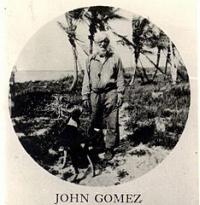
Panther John
Last weekend in Tampa, FL was the annual Gasparilla Pirate Festival. The festival has been a yearly event for the better part of a century. It celebrates the life and times of the “Last Buccaneer,” the pirate Jose Gaspar, also known as Gasparilla, a Spanish Admiral turned brigand who seized over 400 ships between 1789 and 1821. His treasure, none of which has ever been found, is said to be buried all along the Gulf Coast.
Gasparilla’s exploits are legendary. Perhaps, mythological might be an even better description, as there is no evidence that Jose Gaspar ever existed.
While Jose Gaspar has been presented as a historical figure in one or two books, there are no records, artifacts or anything else which might suggest he really existed. He first appears in writing in a brochure to promote a railroad line and a resort hotel in Charlotte Harbor, FL in 1900, near where Gaspar was alleged to have had his pirate base on Gasparilla Island.
If there is no evidence that Jose Gaspe existed, where did the story come from? The answer is probably John Gomez, also known as Juan Gomez, and Panther Key John, Old John, or simply as Panther John. Panther John was definitely real. He was a fisherman, a hunting and fishing guide, a pilot, a sometime filibuster and blockade runner.
Panther John lived on Panther Key at the northern end of Florida’s Thousand Islands. He lived by hunting and fishing and earned a reputation as a skilled boat handler who knew his way around the labyrinthian island chain that is Florida’s Thousand Islands. He was often in demand as a local guide.
No one knows where or when he was born, although John provided many dates and locations to choose from. In the 1870 United States Census, he is listed as having been born in 1828. However, during the 1880 US census, Gómez claimed to have been born in France in 1785. In 1885, he told state census takers that he had been born in Corsica and when asked for the 1900 US Census, he claimed to have been born in Portugal in 1776. Meanwhile, various contemporary letters and news articles report that Gómez claimed at different times to have been born in 1778, 1781 or 1795 in either Honduras, Portugal, or Mauritius. Shortly before his death by drowning in 1900, he claimed to be 123 years old.
In 1894, he was described by a local newspaper as “short, heavy set, and had a beard of heavy curly hair, which had been black but was then silvered all over. He had large, dark eyes, and bore marks of having been a handsome man.”
Panther John was also a teller of tales. He claimed to have fought in the Seminole Wars, to have filibustered in Cuba and sailed as a blockade runner into Tampa during the Civil War. His most interesting tale, however, was how he was the last surviving pirate to have sailed with Gasparilla.
Panther John told the stories about his adventures while acting as a fishing and hunting guide. Various versions of his exploits were ultimately recorded in letters or later appeared in occasional newspaper articles of his day. Interestingly enough, no mention of Gaspar even made it into print in his lifetime. The first recorded reference was in the brochure for a resort hotel, shortly after his death.
After Panther John died in 1900, the legend of Jose Gaspar only grew. Panther John was said to be Gaspar’s cabin-boy or his chief mate. One version said that John was Gaspar’s brother-in-law.
In 1904, Ye Mystic Krewe of Gasparilla, the Tampa organization which sponsors the annual Gasparilla parade, was founded. In 1936, they commissioned a Tampa Tribune editor, Edwin D. Lambright, to write an authorized history of the pirate Gasparilla. His account was presented as factual, based on Gaspar’s diary, which was subsequently lost.
In 2004, they republished Lambright’s account with the notation:
“Whether Gasparilla, the pirate, actually existed or not is a moot point. The legend exists, and that’s what matters. The story of Gasparilla and his pirates has lent a certain flair of mystery and adventure to Florida’s West Coast since the late 1800s. And on that legend, Ye Mystic Krewe of Gasparilla was founded 100 years ago.

Interesting story to say the least.
Here in Maine a similar story yet with out one particular person for the lore. A treasure chest is said to be in the sand bar of “Treasure Island” here in Frenchman’s Bay. My father speculated that the softness of the sand bar would have made any solid treasure that may have been buried there non retrievable as the muck would have swallowed it.
Jose Gaspar lead crucial troops and provided essential local knowledge to Jackson, winning the battle of New Orleans and earning a pardon for his piracy against the enemies of Florida from his base in Galveston bay.
So I was taught in Tampa schools in the ’50s.
That was the 1950s. Today I value seeing that real sciences change as we continually question, re-examine and refine our understanding.
Thanks for the good post.
I was also a victim of a Florida education.